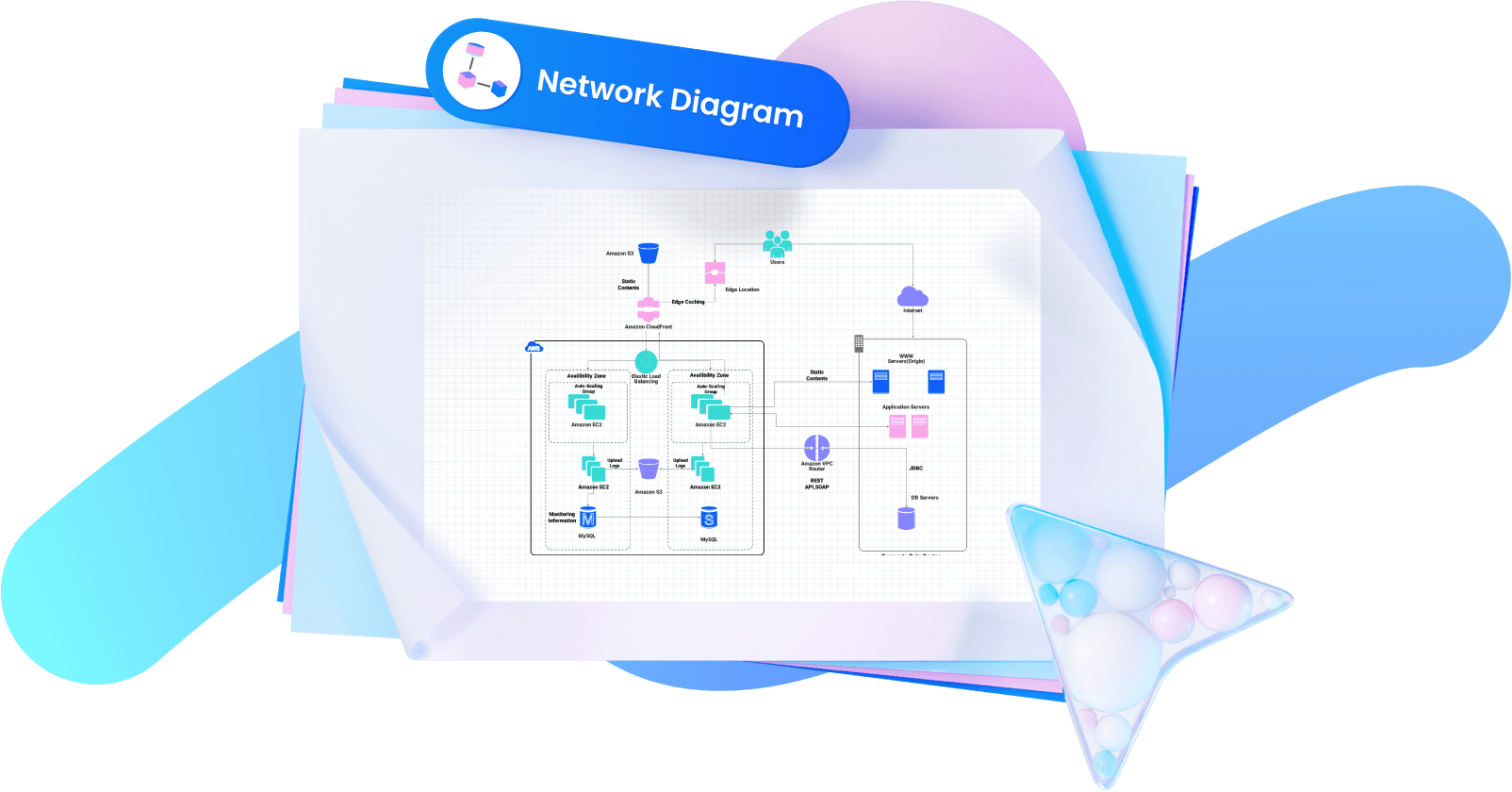
In the dynamic realm of networking, Peer-to-Peer (P2P) Networks stand as a testament to decentralized connectivity, reshaping how information is shared and accessed. This guide embarks on a journey to unravel the essence of P2P networks, offering a comprehensive exploration of their examples, distinctive features, and practical use cases.
From file-sharing platforms to collaborative environments, we delve into the decentralized fabric that underpins modern networking, providing insights into the innovative solutions that have redefined the landscape of digital interconnectivity.
In this article
Part 1. What Is Peer-to-Peer Network?
Peer-to-peer (P2P) networks are a kind of distributed and decentralized network architecture in which users, or "peers," communicate with one another directly and don't require the assistance of a centralized server or authority. Every peer in a peer-to-peer (P2P) network has the same status and can share and consume resources.
The following are some essential traits and attributes of peer-to-peer networks:
- Decentralization: A P2P network operates without a single server or central authority. Rather, peers interact and exchange resources directly with one another, and they all have equal standing.
- Resource sharing: Direct peer-to-peer sharing of resources, such as data, computing power, or bandwidth, is one of the main goals of P2P networks. This makes it possible to use network resources more effectively.
- Scalability: Peer-to-peer networks possess intrinsic scalability because the addition of new peers can augment the network's aggregate capacity and pool of resources. The network gets stronger and can support more traffic as more peers join.
- Autonomy and resilience: In a peer-to-peer network, every peer functions autonomously. The network's ability to function as a whole is not always impacted when a peer fails or leaves. The system's resiliency is enhanced by this autonomy.
- Resource sharing: Users on a peer-to-peer (P2P) network can directly share a range of resources, including files, bandwidth, and processing power.
- Distributed search: To make file searches more effective and less taxing on individual nodes, P2P file-sharing networks, for instance, disperse file searches among all peers.
- Examples: File-sharing networks like BitTorrent, decentralized cryptocurrency networks like Bitcoin, and certain messaging apps that facilitate direct user-to-user communication are a few typical instances of P2P networks.
It's crucial to remember that P2P networks can have many different configurations and functions, but they always have the decentralized and dispersed character of participant interactions.
Figure 1
Part 2. History of peer-to-peer networ
Peer-to-peer (P2P) networks have their roots in the early days of computer networking when decentralized systems were investigated as alternatives to centralized ones. The 1970s ARPANET served as an example of early distributed communication efforts. A decentralized discussion system called Usenet emerged in the 1980s and impacted later P2P technologies. With its centralized file-sharing approach, Napster popularized P2P in 1999. Meanwhile, Gnutella developed decentralized P2P file sharing in 2000. BitTorrent (2001) changed the way files were distributed by enabling multiple downloads from different sources at once.
For big file sharing, eDonkey2000 (2002) integrated decentralized and server-based components. Decentralized P2P transactions gained prominence with the advent of blockchain technology and cryptocurrencies starting in 2009, especially with the introduction of Bitcoin and Ethereum. P2P was further expanded by smart contracts and decentralized apps (DApps). P2P networks' history is a reflection of the transition from centralized to distributed architectures, which has an impact on a variety of fields, including decentralized banking and file-sharing, and shapes the environment of digital transactions and communication.
Types of P2P Networks Different types of peer-to-peers (P2P) networks are created to enable distinct sorts of decentralized communication and cooperation.
- File-sharing networks: This kind distributes the burden and speeds up downloads by enabling users to share and download files directly from one another. BitTorrent and eDonkey are two examples of this protocol.
- Decentralized s>torage networks: By utilizing P2P architecture, platforms such as InterPlanetary File System (IPFS) establish a distributed file system that stores files among a network of nodes, hence decreasing dependence on centralized servers.
- Communication networks: Peer-to-peer (P2P) networks facilitate direct user engagement. Usenet is one of the earlier instances; P2P is used by more recent messaging apps like WhatsApp and Signal to provide direct and secure messaging.
- Material distribution networks (CDNs): peer-to-peer (P2P) CDNs, like Peer5, redistribute web material among users, facilitating faster load times and lessening server burden.
- Blockchain networks: Distributed ledgers, such as Ethereum and Bitcoin, work on peer-to-peer (P2P) networks and validate transactions using consensus techniques in place of a central authority.
- Overlay networks: To facilitate effective routing and resource discovery, overlay P2P networks, like Chord or Pastry, employ a virtual layer on top of the current network infrastructure.
- Collaborative P2P networks: These networks facilitate cooperative projects like Folding@home and SETI@home, in which users provide resources or computing power.
These varied P2P network kinds demonstrate how adaptable decentralized architectures are in meeting different needs for collaboration, storage, and communication across the digital environment.
Part 3. Features of P2P network
Peer-to-peer (P2P) networks differ from conventional client-server designs in several important ways. Here are a few of the noteworthy attributes:
- Decentralization: Decentralization is a key component of peer-to-peer (P2P) networks. In contrast to conventional client-server architectures, P2P networks divide tasks and responsibilities among all linked nodes. Every node in the network has the same status and is capable of serving as a server or a client. This decentralization lowers the possibility of a single point of failure while simultaneously improving system robustness. It makes it possible for networks to be more scalable and resilient, enabling direct participant interaction without the need for a central authority.
- Scalability: P2P networks are particularly scalable, which allows them to easily accommodate fluctuating workloads and adjust to changes in network capacity. The system's overall capacity and efficiency can rise with the number of nodes in the network. For applications like file-sharing or content distribution, where the network needs to support a dynamic and perhaps big user base, scalability is an essential component. P2P networks are scalable in terms of both user count and data volume transferred because of their distributed architecture.
- Self-organization and adaptability: Peer-to-peer (P2P) networks frequently exhibit self-organizing properties that enable nodes to join or exit the network with ease. The network can adjust to structural changes without the need for centralized management. The P2P network's resilience and functionality are guaranteed by this self-organization, even in dynamic circumstances where nodes may regularly go offline or come online. P2P networks are very useful because of their flexibility when nodes have sporadic connectivity or when traffic patterns change on the network. This characteristic enhances P2P systems' overall robustness and effectiveness.
Use Cases of P2P Network Peer-to-peer (P2P) networks, with their decentralized architecture and collaborative capabilities, have found a wide range of applications in several sectors. These are a few noteworthy use cases:
- File sharing: P2P networks became well-known at first because users could share and download files directly from one another using programs like BitTorrent and eDonkey. This decentralized method lessens the load on centralized systems while increasing efficiency.
- Decentralized storage: Decentralized storage options are provided by P2P networks like the InterPlanetary File System (IPFS). Distributing files throughout a network of nodes improves redundancy and lessens reliance on a single point of storage.
- Communication: Signal and WhatsApp are two messaging apps that use P2P architecture. Direct user-to-user communication eliminates the need for a centralized server, improves privacy, and guarantees effective message delivery.
- Content distribution networks (CDN): Peer5 and other peer-to-peer CDNs share web content among users, speeding up load times and minimizing server burden. Large-scale content delivery and streaming services would especially benefit from this.
- Blockchain and cryptocurrencies: P2P networks form the basis of cryptocurrencies such as Ethereum and Bitcoin. Without the need for middlemen, decentralized and secure transactions are made possible by blockchain technology.
- Collaborative computing: P2P networks are used in collaborative computing initiatives such as Folding@home and SETI@home, where users donate their computer power to address complicated issues like simulating protein folding or looking for extraterrestrial civilization.
- Decentralized finance (DeFi): Using P2P networks, certain DeFi apps let users trade, lend, and borrow cryptocurrency without the use of conventional financial middlemen. These transactions are made easier by blockchain platforms' smart contracts.
- Social media: To facilitate user connection, content sharing, and communication without relying on centralized servers, several decentralized social media platforms make use of peer-to-peer (P2P) networks. This method improves data ownership and user privacy.
- Gaming: P2P networks are used in online gaming to facilitate multiplayer communication. Direct connections between game clients and servers’ lower latency and improve gaming responsiveness.
- Distributed computing: P2P networks facilitate models of distributed computing, in which jobs are assigned to several nodes. This is applied in situations such as data analysis, weather modeling, and scientific research.
These applications show how adaptable P2P networks are, showcasing how they may be used to solve a range of problems in a variety of sectors by encouraging decentralization, resource sharing, and cooperative engagement.
Part 4. What Are the Benefits of P2P Connections?
Peer-to-peer (P2P) connections offer several benefits that contribute to their widespread adoption across diverse applications. Firstly, P2P networks enhance scalability, allowing seamless expansion as more nodes join without reliance on a central server. Decentralization reduces the risk of single points of failure, improving system resilience. P2P architectures promote efficient resource utilization, enabling users to share files, processing power, and bandwidth directly.
This results in improved speed, reduced server load, and lower infrastructure costs. The distributed nature of P2P networks enhances data redundancy and security, as information is spread across multiple nodes. Additionally, P2P connections often lead to faster and more responsive communication, making them suitable for real-time applications such as messaging and online gaming. Overall, the benefits of P2P connections include increased efficiency, scalability, resilience, and enhanced resource utilization.




